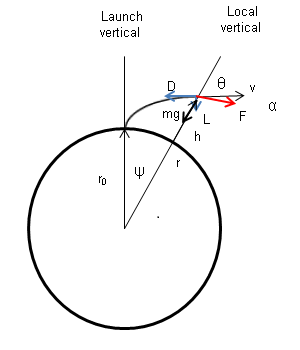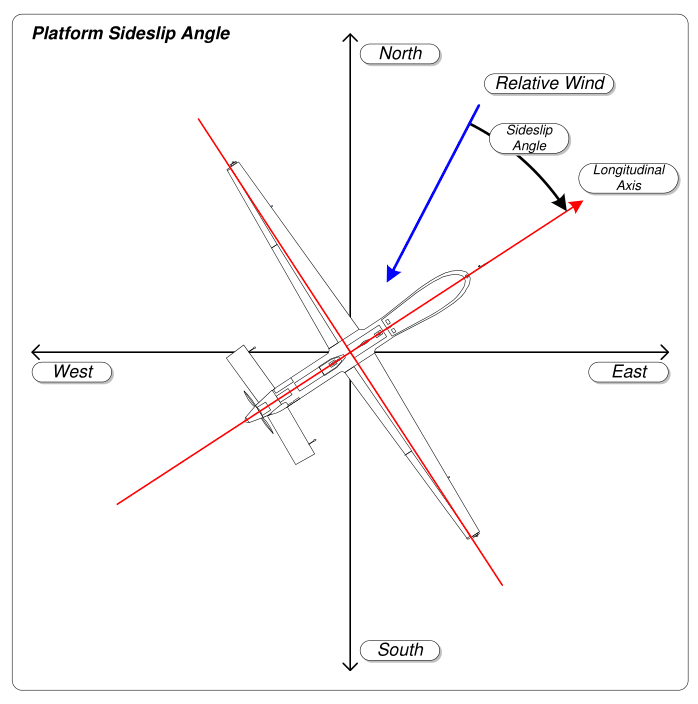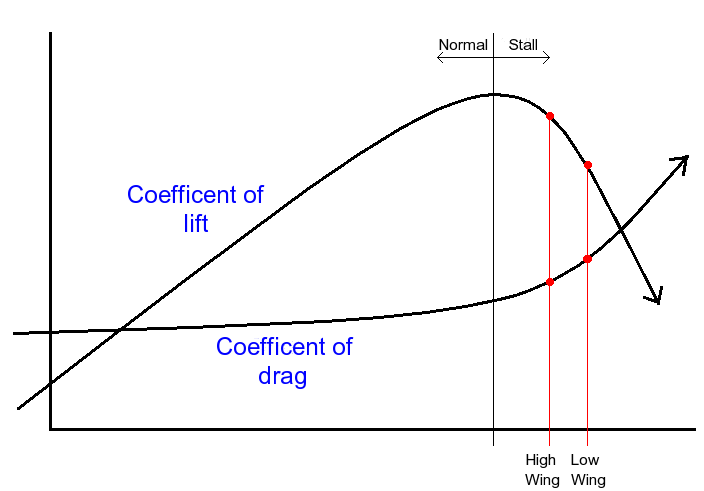|
Skid (aerodynamics)
In a straight flight, the tail of the airplane aligns the fuselage into the relative wind. However, in the beginning of a turn, when the ailerons are being applied in order to bank the airplane, the ailerons also cause an adverse yaw of the airplane. For example, if the airplane is rolling clockwise (from the pilot point of view), the airplane yaws to the left. It assumes a crab-like attitude relative to the wind. This is called a slip. The air is flowing crosswise over the fuselage. In order to correct this adverse slip, the pilot must apply rudder (right rudder in this example). If the pilot applies too much rudder, the airplane will then slip to the other side. This is called a skid. Stall The skid is more dangerous than the slip if the airplane is close to a stall. In the slip, the raised wing — the left one if the airplane is turning to the right — will stall before the lowered one, and the airplane will reduce the bank angle, which prevents the stall. In the skid, ... [...More Info...] [...Related Items...] OR: [Wikipedia] [Google] [Baidu] |
Stabilizer (aircraft)
An aircraft stabilizer is an aerodynamic surface, typically including one or more movable control surfaces, that provides longitudinal (pitch) and/or directional (yaw) stability and control. A stabilizer can feature a fixed or adjustable structure on which any movable control surfaces are hinged, or it can itself be a fully movable surface such as a stabilator. Depending on the context, "stabilizer" may sometimes describe only the front part of the overall surface. In the conventional aircraft configuration, separate vertical (fin) and horizontal (tailplane) stabilizers form an empennage positioned at the tail of the aircraft. Other arrangements of the empennage, such as the V-tail configuration, feature stabilizers which contribute to a combination of longitudinal and directional stabilization and control. Longitudinal stability and control may be obtained with other wing configurations, including canard, tandem wing and tailless aircraft. Some types of aircraft are stabili ... [...More Info...] [...Related Items...] OR: [Wikipedia] [Google] [Baidu] |
Fuselage
The fuselage (; from the French ''fuselé'' "spindle-shaped") is an aircraft's main body section. It holds crew, passengers, or cargo. In single-engine aircraft, it will usually contain an engine as well, although in some amphibious aircraft the single engine is mounted on a pylon attached to the fuselage, which in turn is used as a floating hull. The fuselage also serves to position the control and stabilization surfaces in specific relationships to lifting surfaces, which is required for aircraft stability and maneuverability. Types of structures Truss structure This type of structure is still in use in many lightweight aircraft using welded steel tube trusses. A box truss fuselage structure can also be built out of wood—often covered with plywood. Simple box structures may be rounded by the addition of supported lightweight stringers, allowing the fabric covering to form a more aerodynamic shape, or one more pleasing to the eye. Geodesic construction Geo ... [...More Info...] [...Related Items...] OR: [Wikipedia] [Google] [Baidu] |
Relative Wind
In aeronautics, the relative wind is the direction of movement of the atmosphere relative to an aircraft or an airfoil. It is opposite to the direction of movement of the aircraft or airfoil relative to the atmosphere. Close to any point on the surface of an aircraft or airfoil, the air is moving parallel to the surface; but at a great distance from the aircraft or airfoil, the movement of the air can be represented by a single vector. This vector is the relative wind or the ''free stream velocity vector''.Clancy, L.J. (1975), ''Aerodynamics'', Section 5.2, Pitman Publishing Limited, London The angle between the chord line of an airfoil and the relative wind defines the angle of attack. The relative wind is of great importance to pilots because exceeding the critical angle of attack will result in a stall, regardless of airspeed. In freefall Relative wind is also used to describe the airflow relative to an object in freefall through an atmosphere, such as that of a person's b ... [...More Info...] [...Related Items...] OR: [Wikipedia] [Google] [Baidu] |
Aileron
An aileron (French for "little wing" or "fin") is a hinged flight control surface usually forming part of the trailing edge of each wing of a fixed-wing aircraft. Ailerons are used in pairs to control the aircraft in roll (or movement around the aircraft's longitudinal axis), which normally results in a change in flight path due to the tilting of the lift vector. Movement around this axis is called 'rolling' or 'banking'. Considerable controversy exists over credit for the invention of the aileron. The Wright brothers and Glenn Curtiss fought a years-long legal battle over the Wright patent of 1906, which described a method of wing-warping to achieve lateral control. The brothers prevailed in several court decisions which found that Curtiss's use of ailerons violated the Wright patent. Ultimately, the First World War compelled the U.S. Government to legislate a legal resolution. A much earlier aileron concept was patented in 1868 by British scientist Matthew Piers Watt Bou ... [...More Info...] [...Related Items...] OR: [Wikipedia] [Google] [Baidu] |
Adverse Yaw
Adverse yaw is the natural and undesirable tendency for an aircraft to yaw in the opposite direction of a roll. It is caused by the difference in lift and drag of each wing. The effect can be greatly minimized with ailerons deliberately designed to create drag when deflected upward and/or mechanisms which automatically apply some amount of coordinated rudder. As the major causes of adverse yaw vary with lift, any fixed-ratio mechanism will fail to fully solve the problem across all flight conditions and thus any manually operated aircraft will require some amount of rudder input from the pilot in order to maintain coordinated flight. History Adverse yaw was first experienced by the Wright brothers when they were unable to perform controlled turns in their 1901 glider which had no vertical control surface. Orville Wright later described the glider's lack of directional control. Causes Adverse yaw is a secondary effect of the inclination of the lift vectors on the wing due to its ... [...More Info...] [...Related Items...] OR: [Wikipedia] [Google] [Baidu] |
Flight Dynamics
Flight dynamics in aviation and spacecraft, is the study of the performance, stability, and control of vehicles flying through the air or in outer space. It is concerned with how forces acting on the vehicle determine its velocity and attitude with respect to time. For a fixed-wing aircraft, its changing orientation with respect to the local air flow is represented by two critical angles, the angle of attack of the wing ("alpha") and the angle of attack of the vertical tail, known as the sideslip angle ("beta"). A sideslip angle will arise if an aircraft yaws about its centre of gravity and if the aircraft sideslips bodily, i.e. the centre of gravity moves sideways.Flightwise - Volume 2 - Aircraft Stability And Control, Chris Carpenter 1997, Airlife Publishing Ltd., , p.145 These angles are important because they are the principal source of changes in the aerodynamic forces and moments applied to the aircraft. Spacecraft flight dynamics involve three main forces: propulsive (ro ... [...More Info...] [...Related Items...] OR: [Wikipedia] [Google] [Baidu] |
Slip (aerodynamic)
A slip is an aerodynamic state where an aircraft is moving ''somewhat'' sideways as well as forward relative to the oncoming airflow or relative wind. In other words, for a conventional aircraft, the nose will be pointing in the opposite direction to the bank of the wing(s). The aircraft is not in coordinated flight and therefore is flying inefficiently. Background Flying in a slip is aerodynamically inefficient, since the lift-to-drag ratio is reduced. More drag is at play consuming energy but not producing lift. Inexperienced or inattentive pilots will often enter slips unintentionally during turns by failing to coordinate the aircraft with the rudder. Airplanes can readily enter into a slip climbing out from take-off on a windy day. If left unchecked, climb performance will suffer. This is especially dangerous if there are nearby obstructions under the climb path and the aircraft is underpowered or heavily loaded. A slip can also be a ''piloting maneuver'' where the pilot del ... [...More Info...] [...Related Items...] OR: [Wikipedia] [Google] [Baidu] |
Rudder
A rudder is a primary control surface used to steer a ship, boat, submarine, hovercraft, aircraft, or other vehicle that moves through a fluid medium (generally aircraft, air or watercraft, water). On an aircraft the rudder is used primarily to counter adverse yaw and p-factor and is not the primary control used to turn the airplane. A rudder operates by redirecting the fluid past the hull (watercraft), hull or fuselage, thus imparting a turning or yaw (rotation), yawing motion to the craft. In basic form, a rudder is a flat plane or sheet of material attached with hinges to the craft's stern, tail, or after end. Often rudders are shaped so as to minimize Drag (physics), hydrodynamic or aerodynamic drag. On simple watercraft, a tiller—essentially, a stick or pole acting as a lever arm—may be attached to the top of the rudder to allow it to be turned by a helmsman. In larger vessels, cables, pushrods, or hydraulics may be used to link rudders to steering wheels. In typical air ... [...More Info...] [...Related Items...] OR: [Wikipedia] [Google] [Baidu] |
Stall (flight)
In fluid dynamics, a stall is a reduction in the lift coefficient generated by a foil as angle of attack increases.Crane, Dale: ''Dictionary of Aeronautical Terms, third edition'', p. 486. Aviation Supplies & Academics, 1997. This occurs when the critical angle of attack of the foil is exceeded. The critical angle of attack is typically about 15°, but it may vary significantly depending on the fluid, foil, and Reynolds number. Stalls in fixed-wing flight are often experienced as a sudden reduction in lift as the pilot increases the wing's angle of attack and exceeds its critical angle of attack (which may be due to slowing down below stall speed in level flight). A stall does not mean that the engine(s) have stopped working, or that the aircraft has stopped moving—the effect is the same even in an unpowered glider aircraft. Vectored thrust in aircraft is used to maintain altitude or controlled flight with wings stalled by replacing lost wing lift with engine or propeller t ... [...More Info...] [...Related Items...] OR: [Wikipedia] [Google] [Baidu] |
Spin (flight)
In flight dynamics a spin is a special category of stall resulting in autorotation (uncommanded roll) about the aircraft's longitudinal axis and a shallow, rotating, downward path approximately centred on a vertical axis. Spins can be entered intentionally or unintentionally, from any flight attitude if the aircraft has sufficient yaw while at the stall point. In a normal spin, the wing on the inside of the turn stalls while the outside wing remains flying. It is possible for both wings to stall, but the angle of attack of each wing, and consequently its lift and drag, are different. Either situation causes the aircraft to autorotate toward the stalled wing due to its higher drag and loss of lift. Spins are characterized by high angle of attack, an airspeed below the stall on at least one wing and a shallow descent. Recovery and avoiding a crash may require a specific and counter-intuitive set of actions. A spin differs from a spiral dive, in which neither wing is stalled a ... [...More Info...] [...Related Items...] OR: [Wikipedia] [Google] [Baidu] |
Airfield Traffic Pattern
An airfield traffic pattern is a standard path followed by aircraft when taking off or landing while maintaining visual contact with the airfield. At an airport, the pattern (or circuit) is a standard path for coordinating air traffic. It differs from "straight-in approaches" and "direct climb-outs" in that aircraft using a traffic pattern remain close to the airport. Patterns are usually employed at small general aviation (GA) airfields and military airbases. Many large controlled airports avoid the system unless there is GA activity as well as commercial flights. However, some kind of a pattern may be used at airports in some cases such as when an aircraft is required to go around, but this kind of pattern at controlled airports may be very different in form, shape, and purpose to the standard traffic pattern as used at GA airports. The use of a pattern at airfields is for aviation safety. By using a consistent flight pattern, pilots will know from where to expect other air tr ... [...More Info...] [...Related Items...] OR: [Wikipedia] [Google] [Baidu] |


.png)



.jpg)
